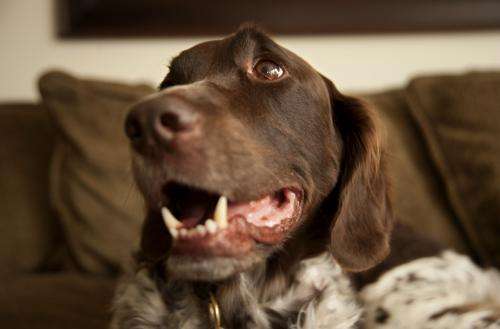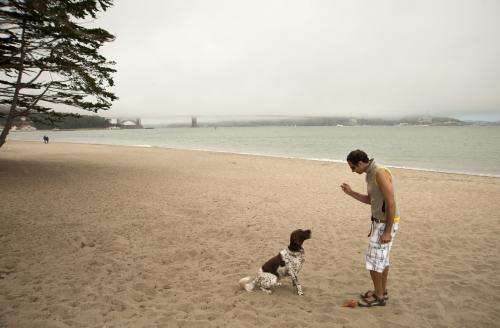Dog jawbones regrown with biomedicine technique

(Phys.org)—Whiskey, an 80-pound Munsterlander dog from San Francisco, still tugs on chew toys and snacks on doggie treats thanks to veterinary surgeons and biomedical engineers at the University of California, Davis, who adapted cutting-edge biomedical technology to regrow jawbones in dogs that have lost bone to injuries or removal of cancerous tumors.
During the past two years, the new experimental reconstructive procedure has proven successful for Whiskey and seven other canine patients at UC Davis' Veterinary Medical Teaching Hospital. Knowledge gleaned from carrying out the procedure in these clinical cases promises to provide valuable information for biomedical treatments in both human and veterinary medicine.
Loss of jawbone may occur in dogs following an injury or, more commonly, when a section of the bone must be surgically removed because it has been invaded by a malignant tumor. Soft-tissue tumors—including squamous cell carcinomas that are responsible for 70 percent of all oral tumors in humans—frequently appear in dogs' mouths and grow into the bone.
"Formerly, when we had to remove a portion of the bone we were forced to leave the defect in the jaw because there was no better alternative," said UC Davis professor Frank Verstraete, who heads the Dentistry and Oral Surgery Service at the veterinary teaching hospital.
He noted that, although the condition is not life threatening, the dog's jaw is never quite the same again in appearance or function, and frequently the dog's teeth traumatize the hard palate and cause ulcerations.
Using the new procedure, surgeons reconstruct the jawbone by means of a titanium plate and screws, and a piece of scaffolding that contains proteins that stimulate regrowth of the bone.

The successful new clinical procedure grew out of a serendipitous collaboration between biomedical engineer Dan Huey and veterinary surgeon Boaz Arzi, when both were working as postdoctoral researchers in the laboratory of biomedical engineering professor Kyriacos Athanasiou, an expert in the biomechanics of cartilage and cartilage healing processes. Huey and Arzi began to discuss biomedical approaches for bone replacement that might have clinical applications for veterinary medicine.
Borrowing from experimental and clinical treatments in human medicine, the pair worked with Verstraete to refine a technique that might work for dogs. In a case like Whiskey's, where bone must be removed to prevent the spread of cancer, the veterinarians first determine how much of the bone must be excised.
Once the diseased section of bone is taken out, the titanium plate is screwed into place on the remaining bone. A stiff, sponge-like chunk of scaffolding material, soaked in a bone growth promoter known as bone morphogenetic protein, is then inserted into the space where the bone was removed. The growth-promoting protein stimulates the dog's remaining jawbone to grow new bone cells, eventually filling the entire defect and integrating with the native bone.
Whiskey was the sixth of eight dogs successfully treated with the new procedure at UC Davis and had the largest section of bone that needed to be removed.
"Because the defect caused by the cancer was 6 centimeters—more than 2 inches wide—we had to amputate about half of Whiskey's lower right jawbone," Arzi said.
Despite the large section of bone removed, Whiskey fared well, as did the other dogs that underwent the procedure. All are alive and doing fine, with well-formed, functional jawbones.
"Within two weeks after the procedure, you could feel bone forming under the skin, and by three months we had new bone that was very similar in density to that of the native bone," Huey said.
Because the procedure has worked so well in these eight cases, the research team is preparing a manuscript about the work for submission to a scientific journal. In future research, they plan to modify the technique for use in larger jawbone defects.
This clinical research builds into UC Davis' strengths in the area of bone regeneration and repair. For example, professor A. Hari Reddi, who holds the Lawrence Ellison Chair in Orthopedics at UC Davis, has studied bone regeneration for more than 40 years and was the first to purify bone morphogenetic protein in the 1980s.
The procedure required that each dog spend three days at the Veterinary Medical Teaching Hospital for a pre-operative examination, surgery and recuperation, followed by three post-operative exams. Total cost for the procedure ranged from $7,000 to $8,000 per dog.
The scaffold material and bone growth proteins were donated by Pfizer Inc. to the UC Davis research team for "compassionate use in animals," as permitted by the U.S. Food and Drug Administration.
Provided by UC Davis















